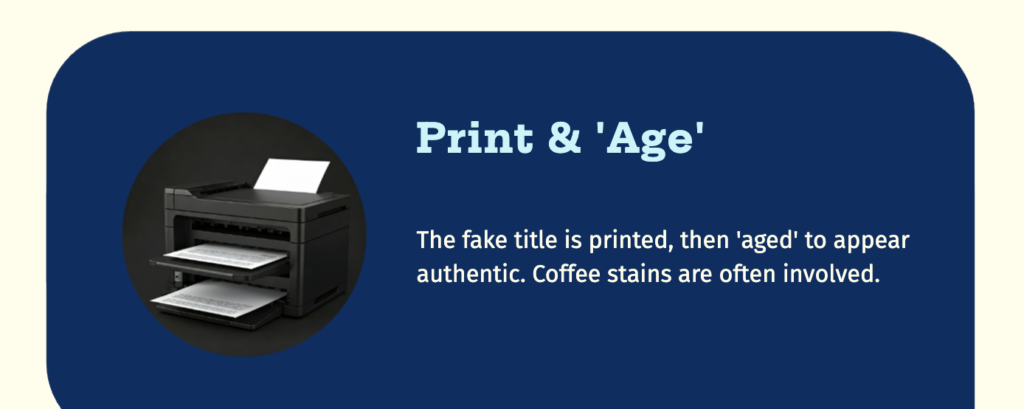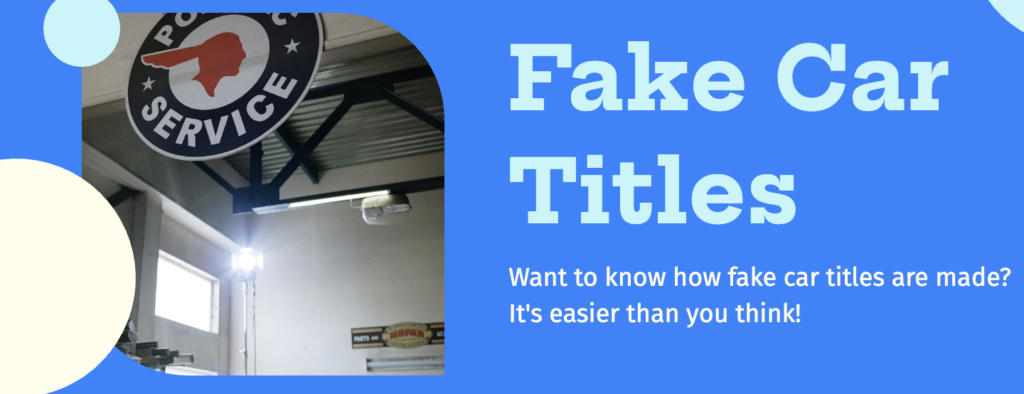Table of Contents
ToggleHow Fake Car Titles Are Made: 5 Simple Steps
Introduction to Fake Car Titles
Car titles are crucial documents in vehicle transactions, establishing ownership and serving as key evidence when buying, selling, or registering a car. However, the rise in fake car titles has become a serious issue, leading to financial and legal troubles for many.
This problem often goes unnoticed until it’s too late, leaving unsuspecting individuals vulnerable to fraud. Fake car titles can look alarmingly real, making it challenging for the average person to identify discrepancies.
Understanding the creation process can help in recognizing and avoiding counterfeit documents. In this post, we will uncover the steps involved in making fake car titles, providing insights into this illicit practice.
Step 1: Gathering Necessary Information

The first step in making a fake car title involves collecting the essential information to make the document appear genuine. This includes details such as the vehicle identification number (VIN), make and model of the car, year of manufacture, and the owner’s personal information.
Obtaining this information often involves unethical practices, such as identity theft, phishing scams, or purchasing data from underground sources. Counterfeiters may also scour public records, social media, or other online platforms to gather the necessary data.
By assembling accurate details, they can produce a fake title that closely mimics a legitimate one. This meticulous collection process is foundational to the success of creating a convincing counterfeit document.
Step 2: Using Design Software

With all the necessary information in hand, the counterfeiter turns to design software to recreate the car title. Programs like Adobe Photoshop and Illustrator are commonly used due to their advanced features and ability to manipulate images and text with high precision.
The software allows for the accurate replication of the document’s design, including logos, fonts, colors, and other specific elements that appear on a legitimate car title. The goal is to ensure every detail matches the original to make the fake title indistinguishable from a real one.
Using layers, filters, and other tools within the software, counterfeiters can mimic the intricate designs and security features of a genuine car title. This step often involves a high level of skill in graphic design, as even minor discrepancies can raise suspicion. To achieve the desired authenticity, counterfeiters might even use templates of real car titles as a base, modifying them to fit the gathered information.
Additionally, design software can aid in replicating holograms, watermarks, and other subtle security features present on an official title. By carefully adjusting transparency, texture, and other visual effects, counterfeiters can create a convincing illusion of these protective elements. The precision offered by modern design software makes it an essential tool in the creation of fake car titles.
Step 3: Printing the Fake Title

Selecting the right type of paper is crucial to avoid detection. Counterfeiters typically use specialty paper that mimics the texture and appearance of official documents, including embedded watermarks and other subtle features.
- The choice of printer is equally important; high-quality laser or inkjet printers are preferred for their ability to produce sharp and clear prints. Some counterfeiters even go the extra mile by using commercial printing services to achieve a more professional finish.
- During the printing process, maintaining the correct alignment and color consistency is essential. Any misalignment or color discrepancies can arouse suspicion. The document must be printed with precise margins and accurate color matching to the original car title. This includes matching any background patterns, text colors, and other design elements that were replicated using design software.
- Additionally, the fake title often needs to be printed in multiple passes to include various layers of information, such as background graphics and foreground text. This layering process helps in creating a more authentic appearance. Special attention is given to replicating any holograms or security threads that might be present in the original document. These elements are usually printed separately and then carefully integrated into the final product.
- Once printed, the counterfeit title undergoes a series of inspections to ensure quality. Any smudges, ink blobs, or other imperfections are corrected. The printed document is also compared to a genuine title to verify its authenticity. This comparison ensures that the fake title is as close to the real thing as possible, reducing the chances of it being identified as counterfeit.
Step 4: Adding Fake Stamps and Seals

Counterfeiters go to great lengths to ensure their fake car titles appear legitimate, and adding fake stamps and seals is a crucial part of the process. These markings often serve as official validation, making them indispensable for a convincing counterfeit.
To replicate these stamps and seals, counterfeiters employ various techniques. Rubber stamps are custom-made to match the specific designs used by state or local authorities. These stamps are often created using specialized machines that can carve intricate designs into rubber. Once the stamps are ready, counterfeiters carefully apply them to the fake title, making sure to match the pressure and ink density of an authentic stamp.
Embossers are another tool frequently used to add a layer of authenticity. These devices create raised impressions on the paper, mimicking the seals found on genuine titles. By carefully aligning the embosser with the pre-printed design on the title, counterfeiters can achieve a seamless look that is difficult to distinguish from the real thing.
In some cases, digital reproductions are employed to create these marks. High-resolution scans of genuine stamps and seals are manipulated using design software to fit the fake title. These images are then printed directly onto the document or used to create new rubber stamps for manual application. The advantage of digital reproductions is the high level of detail that can be achieved, making the fake stamps and seals look incredibly convincing.
To enhance the realism, counterfeiters might even age the stamps and seals. Techniques like light sanding or careful smudging can make the markings appear worn, as if they’ve been handled over time. This attention to detail helps in avoiding detection during casual inspections.
By combining these methods, counterfeiters manage to produce fake stamps and seals that closely mimic those on genuine car titles, making it challenging to identify the document as a fake.
Step 5: Final Touches and Inspection
After adding stamps and seals, counterfeiters conduct a detailed review of the entire document. This involves scrutinizing every aspect to ensure that the fake title looks as genuine as possible. They will check for any visual inconsistencies, such as alignment issues, color mismatches, or text errors, and make the necessary corrections.
The counterfeiters might use magnifying tools to examine the finer details, ensuring that every element matches the original. If the document includes any holograms or special security features, these will be closely inspected for accuracy. Any imperfections detected during this stage are meticulously addressed to avoid raising suspicion.
Additionally, counterfeiters often compare the fake title with a genuine one side-by-side. This comparison helps identify any overlooked discrepancies that might not be immediately apparent. The goal is to make the counterfeit indistinguishable from the authentic document, down to the smallest detail.
This stage may also involve testing the document under various conditions. For example, they might expose the title to UV light to see if it reacts similarly to a real one, or check how it behaves when scanned or photocopied. Any unexpected behavior during these tests could reveal flaws that need correction.
Finally, the document might be subject to a “real-world” test, where it is shown to individuals familiar with genuine car titles to see if it passes casual inspection. Feedback from these tests can provide valuable insights into any remaining imperfections that need fixing.
Conclusion: Risks and Consequences
Engaging in the creation or use of fake car titles is fraught with peril, both legally and financially. The legal consequences can be severe, with potential charges including fraud, forgery, and identity theft. Convictions can result in hefty fines and imprisonment, significantly impacting the lives of those involved.
From a financial perspective, fake car titles can wreak havoc on the car market. Buyers may unwittingly purchase vehicles they don’t legally own, leading to costly legal battles and the potential loss of both the car and the money spent on it. Sellers, too, may find themselves entangled in disputes and legal issues if their vehicles are linked to fraudulent documents.
Additionally, the prevalence of fake car titles undermines trust within the car buying and selling community. It can lead to increased scrutiny and regulatory measures, making the process more cumbersome for everyone involved. This erosion of trust can have a ripple effect, affecting not only individual transactions but also the broader automotive market.
For individuals, the emotional toll of discovering they’ve been duped can be immense. The stress and frustration of dealing with legal proceedings, financial loss, and the potential damage to one’s reputation cannot be understated.
It is, therefore, imperative to exercise due diligence when dealing with car titles. This includes verifying the document through official channels, being wary of deals that seem too good to be true, and consulting with professionals if there’s any doubt about the legitimacy of the paperwork.
Staying informed and vigilant can help mitigate the risks associated with fake car titles, safeguarding both personal and financial well-being.
